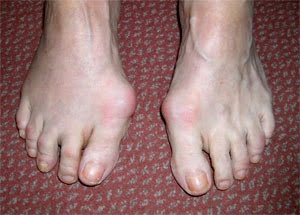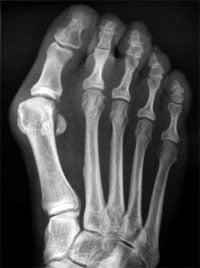Introduction
The term bunion refers to a swelling on the side of the big toe joint, a condition that occurs when the big toe leans too much into the second toe. The medical term for this condition is hallux valgus.
As the swelling is prominent, this area is prone to rubbing from shoes, causing inflammation (redness) and pain.
Hallux Valgus Symptoms
Not all bunions are painful and some people can have large bunions without experiencing significant pain. However the deviating big toe can cause pressure on the second toe, resulting in the second toe becoming a hammer toe. In some cases, the first two toes will cross over, making it hard to walk.


Causes of Hallux Valgus


According to some reports up to 33 per cent of people will develop bunions at some stage in their lives, although the real incidence is probably lower than this. The reason why bunions develop is genetic and the majority of people with bunions have a family history of the condition.
If an individual is prone to developing a bunion, tight footwear is likely to cause the big toe to deform. This is almost certainly the reason why the condition is much more common in females than males. High heeled, pointed toe shoes are not the primary cause of the problem, but such footwear can accelerate the condition.
Other causes of bunions include injury, arthritis and muscle imbalance.
Diagnosis for Bunions Hallux Valgus
It is necessary to take an x-ray in order to determine the extent of the bunion and any associated arthritis.
Bunions Hallux Valgus Treatment
Non-surgical bunion treatment
Around half of all bunion sufferers do not need surgery. The goal of non-surgical treatment is to relieve pressure on the foot and to prevent the development of pressure sores and ulcers.
In some cases, comfortable, well-fitted shoes are sufficient to alleviate pain. A podiatrist can prescribe an orthotic, which is a device inserted into the shoe to prevent the condition from worsening.
It is very important to address any abnormalities in biomechanics. This term refers to foot and lower leg posture during movement.
Surgical bunion treatment
In some cases bunion surgery is the only way to correct the deformity of Hallux valgus and restore “normality” to the big toe, not only in terms of appearances but also in terms of function.
Historically, bunion surgery had a reputation for being very painful, LFAC however, are able to offer more modern types of surgery which are more sophisticated and less invasive. For each patient undergoing bunion surgery, there will be an optimal procedure based on the extent of the deformity but also on the lifestyle of the patient.
The London Foot and Ankle Centre offers an integrated, multi-disciplinary approach, with specialist foot and ankle surgeons working closely with podiatrists and physiotherapists to achieve an optimal recovery solution for the patient with full pain eradication.




